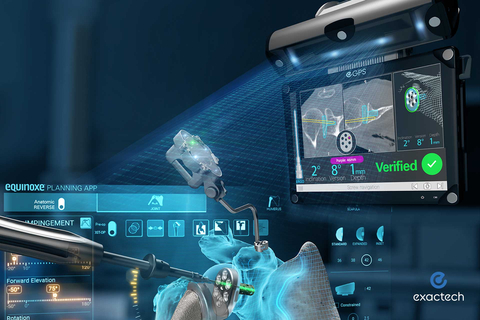GAINESVILLE, Fla.– Exactech, a developer and producer of innovative implants, instrumentation, and smart technologies for joint replacement surgery, announces publication of two new studies that show positive clinical outcomes using the Equinoxe® shoulder preoperative Planning App and ExactechGPS® shoulder intraoperative navigation system.
The first new study, Implications of Navigation System Use for Glenoid Component Placement in Reverse Shoulder Arthroplasty1 (Kida H et al.), is published in Nature’s Scientific Reports. The authors researched the use of ExactechGPS® for glenoid baseplate and screw placement with reverse total shoulder arthroplasty compared to use of conventional instrumentation. The study demonstrated that GPS navigation provided surgeons greater control and helped them more accurately and precisely reproduce their preoperative plan.
“I am very honored to be able to publish our study about the ExactechGPS navigation system,” said study author Atsushi Urita, MD, Ph.D. (Dokkyo Medical University). “Our results showed that the GPS navigation system allowed for greater accuracy and precision implanting the baseplate as compared to conventional instrumentation, with better execution of our preoperative plan for both version and inclination. GPS navigation also allowed for the use of more augmented baseplates, which minimized glenoid reaming to preserve patient glenoid bone. Finally, GPS navigation provided real-time monitoring of screw direction, which resulted in the use of longer screws compared to cases with conventional instrumentation.”
The second paper, High Intraoperative Accuracy and Low Complication Rate for Computer Assisted Navigation of the Glenoid in Total Shoulder Arthroplasty2 (Larose G et al.) is published in the Journal of Shoulder and Elbow Surgery. The authors retrospectively analyzed 16,723 navigated cases with the ExactechGPS system and demonstrated that 98% of cases were completed as planned, with minimal deviation in glenoid version, glenoid inclination, and glenoid positioning relative to the preoperative plan. The authors reported a very low complication rate associated with the use of the navigation system and concluded the system is safe and effective, with only 0.05% of patients experiencing coracoid bone fracture after tracker fixation.
Previous studies have also demonstrated that GPS provides verified placement accuracy within +/-2mm and 2 degrees of the preoperative plan3,4, better glenoid fixation3-6 and improved two-year minimum clinical outcomes compared to non-navigated groups, including improved range of motion and reduced postoperative complications, revision rates and adverse events.7
The GPS system was developed and is manufactured by Blue Ortho, an Exactech company. “We started Blue Ortho with the objective of providing a navigation system that truly makes a difference for surgeons and patients in arthroplasty,” said Anthony Boyer, Blue Ortho President and CEO. “We sought to design a system that was easy to use and seamlessly integrated with Exactech’s implants and instruments to offer the best possible surgeon experience. After 13 years of development and continuous improvement, we could not be more proud to see the level of adoption of this technology, where >40% of Exactech’s shoulders and >20% of Exactech’s knees are implanted worldwide using GPS navigation. We are also proud of the positive clinical experience, as demonstrated by the outcomes detailed in those two studies.”
Added Exactech’s Senior Vice President of Extremities, Chris Roche, “GPS is the first and only shoulder navigation technology that connects the preoperative plan with real-time intraoperative instrument guidance – and verifies implant placement. GPS navigation is a true competitive advantage for Exactech, and more importantly, it is beneficial to our surgeon customers and their patients. We are proud of the results demonstrated by these two new studies, which highlight the real clinical value created by this differentiated orthopedic technology solution.”
1Kida, H. et al. Implications of navigation system use for glenoid component placement in reverse shoulder arthroplasty. Sci Rep. 2022 Dec 7;12(1):21190. doi: 10.1038/s41598-022-25833-8.
2Larose, G. et al. High Intraoperative Accuracy and Low Complication Rate for Computer Assisted Navigation of the Glenoid in Total Shoulder Arthroplasty. JSES. In press. 2022.
3Jones R. et al. Accuracy and precision of placement of the glenoid baseplate in reverse total shoulder arthroplasty using a novel computer assisted navigation system combined with preoperative planning: A controlled cadaveric study. JSES Seminars in Arthroplasty. 2020 May;30(1):73-82.*
4Nashikkar P. et al. Role of intraoperative navigation in the fixation of the glenoid component in reverse total shoulder arthroplasty: a clinical case-control study. J Shoulder Elbow Surg. 2019 Sept.;28(9):1685-1691.
5Nashikkar P. et al. Computer navigation re-creates planned glenoid placement and reduces correction variability in total shoulder arthroplasty: an in vivo case-control study. J Shoulder Elbow Surg. 2019 Dec;28(12):e398-e409.
6Roche C. et al. Impact of screw length and screw quantity on rTSA glenoid fixation for two different sizes of glenoid baseplates. JSES Open Access (JSESOA-D-19-00048R1).*
7Greene A. et al. Two-year clinical outcomes of total shoulder arthroplasty performed with a computer navigated surgery system. Presented at CAOS 2022.
*In vitro (bench) test results may not necessarily be indicative of clinical performance.






